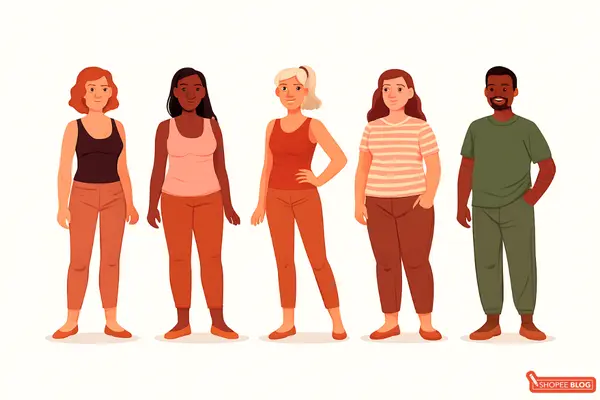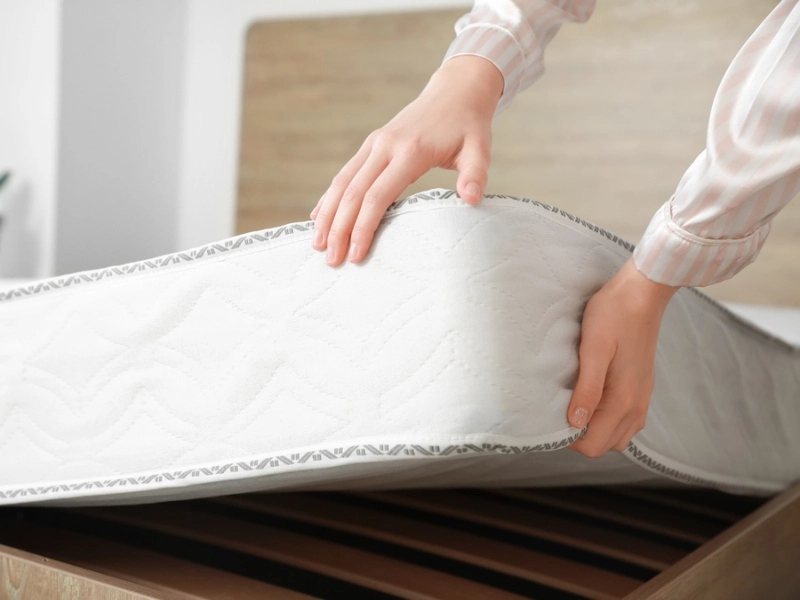Choosing the perfect mattress can feel overwhelming, but it’s one of the most important decisions for your health and well-being. We spend roughly one-third of our lives in bed, so the mattress you sleep on directly impacts your sleep quality. Unfortunately, many people underestimate the importance of their mattress and continue using one that lacks adequate support or comfort. The result? Poor sleep, groggy mornings, and even aches and pains. In this expert guide, we’ll walk you through how to choose the right mattress for a comfortable sleep experience.
Consider your sleeping position

-
Side sleepers
Side sleepers often benefit from a softer to medium mattress that contours to the shoulders and hips. A plush comfort layer will cushion these pressure points so they don’t dig into the mattress. If the bed is too firm, you’ll feel pressure on your shoulder and hip; too soft, and those areas could sink out of line with the rest of your spine.
Recommendation: A Medium Soft to Medium Firm mattress usually works best, offering enough give to relieve pressure while still supporting spinal alignment.
-
Back sleepers
Sleeping on your back naturally distributes weight, but you still need a mattress that supports the lower back’s curve. A medium-firm feel is often ideal to prevent the midsection from sinking too deeply. If a mattress is too soft, your torso may sink and create a “U-shape” bend in your spine; if it’s too hard, it won’t accommodate the slight arch in your lower back.
Recommendation: Medium to Firm mattresses with light cushioning are generally best for back sleepers to maintain proper spinal support.
-
Stomach sleepers
Lying on your stomach puts pressure on the neck and lower back, so it’s crucial to have a mattress that doesn’t sag under your midsection. Most stomach sleepers do well with a firmer mattress that keeps the hips and abdomen elevated, preventing that uncomfortable downward arch in the spine.
Recommendation: Firm (or at least Medium-Firm) support is preferable. This ensures you don’t sink in too much and helps keep your spine straight even when you’re face down.
-
Combination sleepers
If you tend to switch positions through the night, look for a mattress that accommodates all of them. A medium-firm mattress is often the safest bet for combination sleepers, as it provides a balanced feel across positions. You’ll also want a mattress with decent responsiveness (bounce), which makes it easier to change positions. Latex and hybrid mattresses, for example, tend to offer more bounce, which combination sleepers may appreciate.
Know your body type and weight

-
Weight and firmness
Your body weight influences how far you sink into a mattress. Lighter individuals (under 60 kg) don’t compress the layers as much, so they often feel more comfortable on mattresses that are on the softer side to allow for enough contouring. Heavier individuals (over 100 kg) will sink deeper, so they generally need a thicker, firmer mattress to prevent excessive sagging and keep the spine supported.
-
Body shape
If you have broad shoulders or wider hips, you may need a mattress with a bit more pressure relief (softer comfort layers) to accommodate those areas, especially if you’re a side sleeper. This allows the mattress to cushion your shoulders/hips and keep your spine straight.
On the other hand, people with a more uniform weight distribution might be comfortable on a variety of mattress types as long as overall support is adequate. The key is to ensure that the mattress lets your heavier or wider body parts sink in just enough to align with the rest of you, without sagging or creating awkward angles.
-
Height and mattress size
If you’re particularly tall (~1.8m), mattress length becomes crucial. A standard Singapore queen or king is about 190 cm in length, which might be just barely enough for a six-foot-tall person. Consider opting for sizes or models that offer extra length if you need it – there’s nothing worse than having your feet hang off the bed! Here’s a quick overview of common mattress sizes available:
| Single (91 cm x 190 cm) | Ideal for children or single sleepers with limited space |
| Super Single (107 cm x 190 cm) | Provides a bit more space for single sleepers |
| Queen (152 cm x 190 cm) | A popular choice for couples or individuals who enjoy extra space |
| King (182 cm x 190 cm) | Offers maximum sleeping area, perfect for couples who value space |
Mattress types and materials
-
Memory foam

Memory foam mattresses are made of high-density foam that contours closely to your body, providing excellent pressure relief. They’re fantastic for side sleepers and anyone who enjoys that “hugging” sensation when lying down. Memory foam excels at motion isolation, meaning if you sleep with a partner, you won’t feel each other tossing and turning as much.
On the downside, traditional memory foam can trap heat, so look for newer gel-infused or open-cell foams if you tend to sleep hot. These mattresses are ideal if you want soothing pressure relief for achy joints or back pain (many people with back issues find memory foam helpful), but if you prefer a bouncy or very cool bed, you may need to consider other options.
-
Innerspring

Innerspring mattresses are the classic design most of us grew up with – a core of steel coil springs that provide support, topped with some cushioning layers. They tend to be bouncier and more breathable due to the space between coils, which is great for hot sleepers and those who like a traditional feel. Modern innersprings often have a pillow-top or euro-top layer to add comfort.
However, innersprings usually provide less contouring and pressure relief than foam. You might feel more motion transfer (i.e., if your partner moves, the spring bed might jostle you a bit). These mattresses can be a good choice for back and stomach sleepers or heavier individuals who need firm support, as well as shoppers on a budget (since innersprings are often more affordable).
-
Hybrid

Hybrid mattresses combine the best of both worlds: they have an innerspring coil support core plus substantial foam or latex layers on top. A well-designed hybrid can offer balanced comfort – the support and responsiveness of coils, along with the pressure relief and motion isolation of foam. Hybrids come in many varieties; some use memory foam on top, others use latex or even mini coils in the comfort layer. They tend to have medium to high levels of support and moderate contouring. Hybrids are often a great compromise for couples or combination sleepers, because they can suit a wide range of positions depending on how they’re built.
-
Latex

Latex mattresses use foam crafted from latex rubber (either natural or synthetic). Latex has a buoyant, springy feel – it doesn’t hug you as closely as memory foam, but it still offers light contouring along with a lot of responsiveness. Natural latex is also prized for being eco-friendly and hypoallergenic (it’s naturally resistant to dust mites and mould). These mattresses are great for people who want bounce and durability – latex is very resilient and can last a long time. They also tend to sleep cooler than memory foam.
However, latex mattresses can be on the pricier side, especially the natural and organic varieties. They are a top pick for eco-conscious shoppers and those who want a mattress that’s both supportive and gently cushioning.
-
Airbed

Airbed mattresses (not to be confused with temporary air mattresses) have air chambers inside that provide the support, often adjustable via a pump. High-end airbeds (like Sleep Number beds) allow you to fine-tune the firmness on each side of the bed with the push of a button. This makes them popular with couples who have very different firmness preferences – each person can customise their side. Airbeds can offer good support and pressure relief if adjusted correctly, and flexibility is their biggest selling point.
On the flip side, they tend to be very expensive, and more components mean more parts that could potentially malfunction. They’re a niche choice, but worth considering if personalisation is your top priority.
Choosing the best mattress: How do you pick the right firmness?

Firmness refers to how soft or hard a mattress feels when you lie on it. Mattress companies often describe their beds as Plush/Soft, Medium, Firm, or Extra Firm, sometimes using a numeric scale (typically 1-10, where 1 is ultra soft and 10 is rock hard). But one brand’s “Medium” can feel like another’s “Soft,” so use these labels as a general guide rather than a strict rule.
-
Think about your current bed
If you often wake up feeling it’s too soft (sinking or sagging), consider going one level firmer. If it feels too hard (you feel pressure on your hips or shoulders), explore something a bit softer.
-
Test in person if possible
Nothing beats lying on a mattress to judge comfort. Visit showrooms or malls and try out mattresses for at least 10 – 15 minutes in your usual sleep position. Don’t be shy – kick off your shoes and really settle in. Pay attention to whether you feel pressure or discomfort, and whether your spine feels neutral.
-
Leverage sleep trials
If buying online (or even in-store from companies that offer it), take advantage of mattress trial periods (typically 100 nights or more) to sleep on the mattress and see how you like the firmness in real life. We’ll discuss trials more in a moment, but it’s a fantastic safety net for firmness choice because you can usually exchange or return it if it’s not the right fit.
Temperature and climate considerations

Do you tend to sleep hot, or is your bedroom warm and humid? If so, mattress temperature regulation is a big factor to think about. In a tropical climate like Singapore’s, a mattress that sleeps cool can make a real difference in comfort. Here are some tips to stay cool:
-
Breathable materials
Traditional memory foam is known for trapping heat, but many newer mattresses combat this with cooling features. Look for open-cell foam designs or foams infused with cooling gel – these are made to dissipate heat and prevent the bed from turning into an oven. Similarly, mattresses with inner springs or ventilated latex tend to allow more air circulation than solid foam beds, helping heat escape.
-
Cooling covers and fabrics
Some mattresses come with specialised covers made of moisture-wicking, breathable textiles. Natural cotton and bamboo-based fabrics (like Tencel) are great at drawing heat and sweat away from your body. High-quality mattress covers may also include phase-change materials or yarns that feel cool to the touch. If overheating is a concern, pay attention to these details in the product specs.
-
Airflow and design
The internal design can also affect cooling. For example, hybrids and innersprings inherently have more airflow because of the coil layer. Some foam mattresses are engineered with airflow channels or perforations to enhance ventilation. Even just having a mattress with a convoluted (egg-crate shaped) foam layer on top can promote a bit more airflow than a flat slab of foam. Every bit helps when combating night sweats.
How to choose a mattress for back pain

If you suffer from back pain, mattress choice becomes even more critical. The right mattress can significantly reduce pain and stiffness, while the wrong one can exacerbate your problems. So, how to pick a mattress for back pain?
-
Support is non-negotiable
An old, saggy mattress or one that’s overly soft can let your midsection sink in too far, throwing your spine out of alignment. On the other hand, a rock-hard mattress might push on your hips and shoulders and fail to support your lower back’s curve.
Most people with back pain do best on a medium-firm mattress, which numerous studies have found to be optimal for spinal support and pain relief. Medium-firm doesn’t mean “hard” – it still has enough cushioning to be comfortable – but it ensures your back isn’t sagging while you sleep. Of course, individual preference matters, but use medium-firm as a starting point and adjust up or down in firmness depending on what feels best for your back.
-
Pressure relief for pain points
There are two aspects to look for: proper support and pressure relief. If you have chronic back pain, especially lower back (lumbar) pain, you want a mattress that supports the lumbar region. Some mattresses have zoned support (firmer in the middle) to address this. Equally important, you need pressure relief so that your body can relax.
Memory foam and latex are known for their ability to distribute weight and relieve pressure on joints. In fact, memory foam mattresses often provide excellent support for those with back pain because they mould to your body’s shape, filling in gaps like the lower back and supporting the natural curve. If you dislike the feel of foam, a hybrid with a thick comfort layer or a high-quality spring mattress with a plush topper can also do the job.
-
Spinal alignment
Pay attention to how you sleep as well. If you’re a side sleeper with back pain, you’ll still need that softer top to cushion hips and shoulders (to avoid new pressure issues), but with enough support underneath. If you’re a back sleeper with back pain, maintaining that gentle curve in your lower spine is crucial – you might even consider a small pillow under your knees for relief.
Stomach sleeping is generally not advised for back pain (it tends to twist the neck and stress the back), but if it’s the only way you sleep, then a firm mattress is absolutely necessary to prevent your hips from bowing downwards.
-
Try adjustments
When your new mattress arrives, give it some time and notice your pain levels. Sometimes, pairing your mattress with the right pillow (to keep your neck aligned) or an adjustable base (to elevate your legs slightly) can further help with back pain.
Also, note if your pain is worse in the morning (sign of mattress issues) versus at the end of the day (likely daily activity or posture issues). If morning pain persists even after a mattress upgrade, consider consulting a healthcare professional – but at least you’ll have ruled out the mattress as a culprit.
Budget and value for money

You can find very cheap mattresses out there, but be cautious – a super low price might signal subpar quality or durability. On the other hand, the most expensive mattress isn’t automatically the best. Here’s how to approach the budget question:
-
Think long-term investment
Rather than viewing a mattress as just another purchase, consider its cost spread out over the years you’ll use it. A good quality mattress generally lasts around 7 to 10 years (some even longer). It’s often more cost-effective to invest a bit more upfront in a bed that will support you properly and hold up well, than to buy a bargain mattress that sags or wears out in just a couple of years. Calculate the “cost per night” of a mattress – you might find that an extra few hundred dollars for a better bed comes down to just cents per night over its lifespan, which is a worthy investment in your sleep quality.
-
Set a realistic budget
By all means, have a budget range in mind. Mattresses in Singapore can vary from a few hundred dollars for basic models to several thousand for high-end luxury brands. Identify what features matter most to you (e.g., maybe you’re willing to spend more for a natural latex or a reputable brand with a 15-year warranty). This helps in deciding where to splurge and where to save.
| Mattress type | Approximate cost | What you’re getting |
| Basic Foam / Spring | S$100 – S$500 | Entry-level models, thinner layers, fewer features. Good for guest rooms or short-term use. |
| Foam/Hybrid) | S$500 – S$1,500 | Better comfort layers, pocket springs/hybrid builds, decent durability. |
| Memory Foam / Latex / Advanced Hybrid | S$1,500 – S$4,000+ | High-end materials (natural latex, advanced cooling, zoned support). For long-term investment. |
| Luxury / Ultra Premium | S$4,000 – S$10,000+ | Top brand names, custom sizing, boutique materials, long warranties. |
Trial periods and warranties

Even after doing all this homework, you really won’t know if a mattress is right for you until you’ve slept on it for a while. That’s why mattress trial periods and warranties are so important. Any reputable mattress brand or retailer today will give you a trial period to test the mattress at home, as well as a warranty to protect against defects. Here’s what to look for:
-
Sleep trial
A sleep trial is essentially a return window during which you can try out the mattress and still exchange or get a refund if it’s not working for you. Many brands offer risk-free trial periods of around 90 to 120 nights, and some go even longer – up to a full year in certain cases. Make sure you understand the terms: some require a minimum trial (e.g., you must keep it at least 30 days before return, since it can take a few weeks for your body to adjust to a new mattress), and ask if returns are truly free (will they pick it up and give a full refund?).
A generous trial period is a strong sign the company stands behind its product, and it gives you peace of mind in case you realise that the medium-firm feel you chose is still too soft or too hard for your liking.
-
Warranty
A good mattress should come with a long warranty, often around 10 years or more. This warranty typically covers manufacturing defects or premature sagging beyond a certain depth (for example, if the foam inside cracks or the springs collapse unnaturally). Essentially, the warranty is the company’s promise that its product will last.
Be sure to read the warranty details – it may not cover normal softening or wear, and using the mattress on an improper base could void it. Some high-end brands even offer 15- or 20-year warranties. Still, realistically, a decade of coverage is standard and usually sufficient, given you’ll likely replace the mattress by the time 10 years are up.
How to choose the right mattress for a comfortable sleep experience
Choosing the best mattress comes down to understanding your personal needs and doing a bit of homework – but the payoff is huge in terms of better sleep and health. By considering your sleeping position, body type, preferred materials, and ensuring a balance of comfort and support, you can confidently pick a mattress that feels “just right”. To further enhance your slumber, you might explore relaxing sleep aids like the best essential oils for sleep or ensure you’re cosy with the best blankets Singapore has to offer.






















